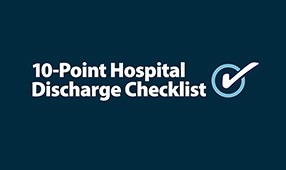Brianna Miller, a middle-school math teacher in Boston, was doing her best to manage a rare neurological disorder through medication and acupuncture for several years. But in December 2020, she found herself enveloped in a “brain fog.”
“I was miserable and a lot less effective than I was willing to admit,” Miller says. “At one point, I forgot my name in the middle of a class and realized I had to take a leave. Around that point, my doctors decided that surgery was probably going to be my only real course of action.”
No teacher wants to take time away from his or her students in the middle of the school year, especially for medical reasons. But with the right mix of preparation and communication, teachers can set their students—and themselves—up for success.
Take action to protect your finances
If you have a health condition that could eventually result in an extended leave of absence, or you just want to be prepared in case an unexpected illness or injury occurs, you’ll first want to ensure your income will be protected while you’re recuperating so you can cover your bills and avoid payment delinquencies and credit hits.
Through your NEA membership, you have exclusive access to two kinds of insurance that can help: disability income insurance and hospital income insurance. First, check to see what kinds of health conditions are covered by the NEA Income Protection Plan. Additionally, the NEA In-Hospital Indemnity Plan could help you cover the costs associated with a hospital stay, such as home health care, medical equipment and other related expenses.
Know your school’s process for taking extended leave
When you know you’ll need to take time off for medical leave, short-term disability or long-term disability may be applicable, although the procedures for requesting and receiving approval vary from state to state and district to district. Most typically, teachers complete a request form, obtain documentation from their physician, and use their stored-up sick days while they’re away.
In Boston, Miller had to specify her return date, but she was allowed to apply for an extension up to two weeks before her scheduled return.
“It was all fairly straightforward,” Miller says. “Of course, there was some paperwork drama. Something from my doctor didn’t get there in time. But my administration was very helpful about pushing things through.”
Work with your principal to cover your class
If you have some advance notice that you’ll be away from school for a while, it’s important to loop in your principal as early as possible so that he or she can prepare.
“Your principal will be hiring a guest teacher for your absence, and that’s a big responsibility,” notes Michael Wellman, a fifth-grade teacher in the Seattle area. Wellman was out of the classroom for a total of nine weeks during the 2020-2021 school year, sidelined by a virus.
Lean on your colleagues for assistance
Although a long-term substitute teacher from outside the school most likely will be the person who teaches your students in your absence, your colleagues also can be an enormous asset. If you’re one of a team of third-grade teachers, for instance, the other people on your team may be willing to share resources with your sub and help him or her acclimate to your school.
In Miller’s case, another sixth-grade math teacher at her school agreed to digitally share all of her lesson plans and assignments with Miller’s sub.
Wellman says that the other fifth-grade teachers at his school wrote lessons for his students in his absence, and the school librarian helped to orient the long-term sub to the school.
Prepare your substitute teacher to take over
The amount of prep you’ll be able to do will depend on how much advance warning you have that you’ll be away.
“I ended up going to the hospital one day, and so all of a sudden they had to find a guest teacher,” Wellman says. “If I’d had more time to prepare, I would have written more detailed plans. It’s easy to write sub plans ahead of time, but if you’re sick, it becomes impossible.”
Miller had more time to prepare. She scheduled her extended medical leave to start at the beginning of winter break, and she spent some time over the break showing her sub what she had done with students and where to find various resources.
“We were able to hand off fairly cleanly in terms of planning,” Miller says. “If I had the time and bandwidth, I definitely would have left more detailed instructions. The prep I did helped, and I wish I’d been able to do more.”
Tell your students you’ll be out for a while
For Miller, telling her students about her impending absence was a tricky balance. On the one hand, she wanted her students to be mentally prepared. But on the other, she didn’t want them to worry—or to mentally “check out,” knowing that she would be leaving them soon for an extended period.
“I’m ordinarily much more open with my students, but I’ve never dealt with anything like this before,” she says. She decided to tell them one week in advance that she was taking medical leave—and didn’t share details.
“I thought that a lot of notice would either make them very concerned, or else make them think they could just slack off,” she says. “I didn’t want to surprise them, but I also didn’t want them dwelling on it.”
Wellman didn’t have an opportunity to prepare his students. If he had had more notice, he says, “I would have told them exactly what was going on, how long I’d be out, and my anticipated return. I’d also encourage them to do their best and keep going strong with the guest teacher.”
Communicate with parents about your situation and plans
Miller sent out a letter to all of her students’ families before the start of her leave. “It was just a note explaining that I would be out, explaining that there would be a sub, and giving them the sub’s contact info,” she says.
It’s also important to establish boundaries, letting parents know you won’t be available while you’re on leave. “Some called me in January, while I was still on leave,” Miller says, “and I had to say, ‘Sorry,’ and then they were very understanding.”
“If I’d been able to prepare parents,” Wellman says. “I would have given them some information about what kind of work would be coming up over the next bit of time. Parents need to feel like things will be as normal as possible and that the students will be continuing through the curriculum.”
Let go emotionally so you can focus on your healing
After all of the hard work teachers put into establishing norms, building relationships, and instructing students, you often (understandably) feel a keen sense of ownership over your classroom. It can be difficult to cede control to another teacher, and there’s often a temptation to worry over every detail of what’s happening while you’re away—and maybe even check in.
However, resisting this impulse provides two positive outcomes: It will allow you to focus on your health, and it’ll help give your students and parents confidence in the substitute teacher.
“You’ve got to turn it over to the guest teacher so it can become his or her classroom for that period of time,” Wellman says.
“It was difficult to not micromanage from afar,” Miller admits. “I have one student who is very conscientious and lovely, and also a little too addicted to texting his teachers for help. He texted me and said, ‘I don’t understand what the sub is doing.’ I had to say, ‘It’s all right, I’ll be back soon.’ I do think it was very important to let go, and that was very hard for me.”
Give yourself time to adapt when you return
Wellman says of his transition back into the classroom was fairly smooth: “I knew where they were in the curriculum. The kids change a lot over a couple of months, so I had to get to know them again. Their skills had grown. It took a couple of weeks to get back in the real groove, and then it was kind of like I hadn’t been gone at all.”












